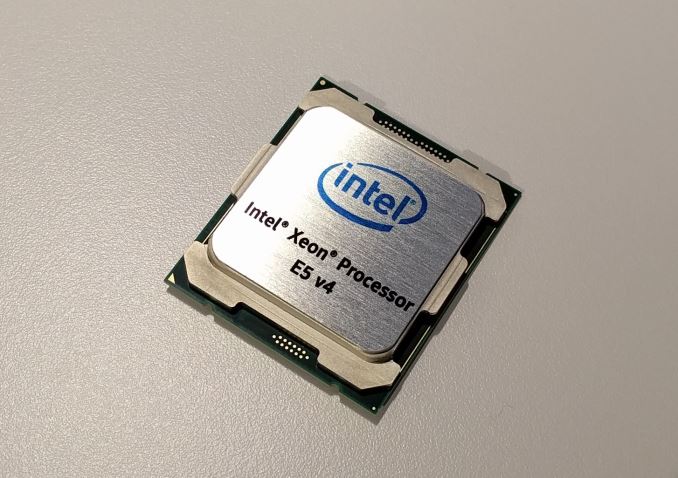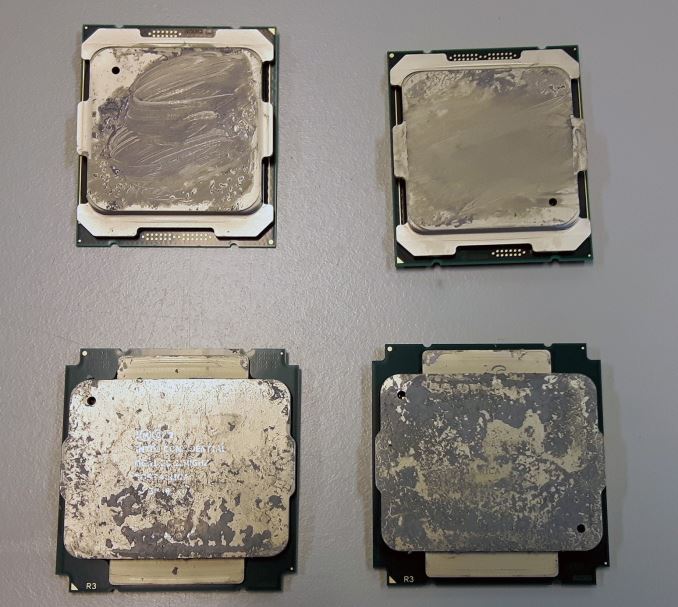The Intel Xeon E5 v4 Review: Testing Broadwell-EP With Demanding Server Workloads
by Johan De Gelas on March 31, 2016 12:30 PM EST- Posted in
- CPUs
- Intel
- Xeon
- Enterprise
- Enterprise CPUs
- Broadwell

We have been spoiled. Since the introduction of the Xeon "Nehalem" 5500 (Xeon 5500, March 2009), Intel has been increasing the core counts of their Xeon CPUs by nearly 50% almost every 18 months. We went from four to six (Xeon 5600) on June 2010. Sandy Bridge (Xeon E5-2600, March 2012) increased the core count to 8. That is only 33% more cores, but each core was substantially faster than the previous generation. Ivy Bridge EP (Xeon E5-2600 v2, launched September 2013) increased the core count from 8 to 12, the Haswell-EP (Xeon E5-2600 v3, sept 2014) surprised with an 18-core flagship SKU.
However it could not go on forever. Sooner or later Intel would need to slow down a bit on adding cores, for both power and space reasons, and today Intel has finally pumped the brakes a bit.
Launching today is the latest generation of Intel's Xeon E5 processors, the Xeon E5 v4 series.Fifteen months after Intel's Broadwell architecture and 14nm process first reached consumers, Broadwell has finally reached the multi-socket server space with Broadwell-EP. Like past EP cores, Broadwell-EP is the bigger, badder sibling of the consumer Broadwell parts, offering more cores, more memory bandwidth, more cache, and more server-focused features. And thanks to the jump from their 22nm process to their current-generation 14nm process, Intel gets to reap the benefits of a smaller, denser process.
Getting back to our discussion of core counts then, even with the jump to 14nm, Intel has played it more conservatively with their core counts. Compared to the Xeon E5 v3 (Haswell-EP), Xeon E5 v4 (Broadwell-EP) makes a smaller jump, going from 18 cores to 24 cores, for an increase of 33%. Yet even then, for the new Xeon E5 v4 "only" 22 cores are activated, so we won't get to see everything Broadwell-EP is capable of right away.
Meanwhile the highest (turbo) clockspeed is still 3.6 GHz, base clocks are reduced with one or two steps and the core improvements are very modest (+5%). Consequently, performance wise, this is probably the least spectacular product refresh we have seen in many years.
But there are still enough paper specs that make the Broadwell version of the Xeon E5 attractive. It finds a home in the same LGA 2011-3 socket. Few people will in-place upgrade from Xeon E5 v3s to Xeon E5 v4s, but using the same platform means less costs for the server vendors, and more software maturity (drivers etc.) for the buyers.

They look very different but fit in the same socket: Xeon E5 v4 on top, Xeon E5 v3 at the bottom
Broadwell also has several features that make it a more attractive processor for virtualized servers. Finer granular control over how applications share the uncore (caches and memory bandwidth) to avoid scenarios where low priority applications slow down high priority ones. Meanwhile quite a few improvements have been made to make the I/O intensive applications run smoother on top of a virtualized layer. Most businesses run their applications virtualized and virtualization is still the key ingredient of the fast growing cloud services (Amazon, Digital Ocean, Azure...), and more and more telecom operators are starting to virtualized their services, so these new features will definitely be put to good use. And of course, Intel made quite a few subtle - but worth talking about - tweaks to keep the HPC (mostly "simulation" and "scientific calculation software) crowd happy.
But don't make the mistake to think that only virtualization and HPC are the only candidates for the new up-to-22-cores Xeons. The newest generation of data analytics frameworks have made enormous performance steps forward by widening the network and storage bandwidth bottlenecks. One example is Apache Spark, which can crunch through terabytes of data much more efficiently than its grandparent Hadoop by making better use of RAM. To get results out of a massive hump of text data, for example, you can use some of most advanced statistical and machine learning algorithms. Mix machine learning with data mining and you get an application that is incredibly CPU-hungry but does not need the latest and fastest NVMe-based SSDs to keep the CPU busy.
Yes, we are proud to present our new benchmark based upon Apache Spark in this review. Combining analytics software with machine learning to get deeper insights is one of the most exciting trends in the enterprise world. And it is also one of the reason why even a 22-core Broadwell is still not fast enough.










112 Comments
View All Comments
Casper42 - Thursday, March 31, 2016 - link
HPE just dropped the 64GB LRDIMMs a week or two back.They are now exactly 2x the 32GB LRDIMM as far as List Price goes.
LRDIMMs across the board are 31% more expensive than RDIMMs.
wishgranter - Tuesday, April 5, 2016 - link
http://www.techpowerup.com/221459/samsung-starts-m...wishgranter - Tuesday, April 5, 2016 - link
While introducing a wide array of 10nm-class DDR4 modules with capacities ranging from 4GB for notebook PCs to 128GB for enterprise servers, Samsung will be extending its 20nm DRAM line-up with its new 10nm-class DRAM portfolio throughout the year.nathanddrews - Thursday, March 31, 2016 - link
Perf/W is obviously a very exciting metric for server farmers and it generally exciting from a basic technology perspective, but it's absolute performance isn't amazing. Anyway, it's not like I'll be buying one anyway. LOLasendra - Thursday, March 31, 2016 - link
This interest me in so far as this would be the updated processors in a supposedly-coming-this-year Mac Pro refresh. Not that I would personally fork that much cash, but I'm interested to see how much of a jump they will make.But things seam rather bleak. No wonder they decided to wait 3 years for a refresh.
MrSpadge - Thursday, March 31, 2016 - link
Not sure which years you're counting in, but for the majority of us it takes 1.5 years from 09/2014 to today.https://en.wikipedia.org/wiki/Haswell_%28microarch...
asendra - Thursday, March 31, 2016 - link
Apple didn't update the MacPros with Haswell-EP. They are still using Ivy Bridgetipoo - Thursday, March 31, 2016 - link
Wonder what they'll do on the GPU side though. Too early for next generation 14nm FF GPUs from anyone, if Nvidia was even a choice due to OpenCL politics. Another GCN 1.0 part in 2016 would be...A bag of hurt.
Still waiting on the high end 15" rMBP to have something better than GCN 1.0...The performance, shockingly, hasn't come all that far from even my Iris Pro model. Maybe double, which is something, but I'd like larger than that to upgrade from integrated...
extide - Thursday, March 31, 2016 - link
Nah, if they refresh it late this year, like in august or something like that, then 14/16nm FF GPU's will be available.At worst we would get GCN 1.2, but yeah it would suck to see 28nm GPU's put in there...
mdriftmeyer - Thursday, March 31, 2016 - link
On what planet do you not grasp FinFET 14nm end of June from AMD?